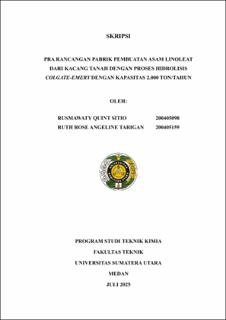| dc.description.abstract | The production of peanuts in Indonesia has been declining each year. This is
presumed to be due to the use of peanuts being limited mainly to food products.
Utilizing peanuts as a chemical raw material, such as linoleic acid, is expected to
increase peanut production in Indonesia in the future. Each year, the demand for
linoleic acid in Indonesia continues to grow, yet there is currently no factory in the
country that specifically produces linoleic acid. Therefore, the establishment of a
linoleic acid plant becomes a viable alternative to meet this demand. The
Preliminary Design of a Linoleic Acid Plant from Peanuts Using the Colgate-Emery
Hydrolysis Process with a Capacity of 2,000 Tons/Year requires a raw material
input of 1,908 kg/hour. This plant will go through several main processes: pre
treatment, extraction, degumming, hydrolysis, flash tank operation, and fatty acid
crystallization. The planned business entity is a Limited Liability Company (PT)
with a line and staff organizational structure, requiring a total of 135 workers. The
plant is planned to be located in Medang Deras Subdistrict, Batubara Regency,
North Sumatra, with a land area of 18,630 m². The total investment required is IDR
306,288,935,754, with production costs of IDR 239,885,893,370, sales revenue of
IDR 312,675,384,447, and a net profit of IDR 53,937,012,888. Based on feasibility
analysis, the project yields a Profit Margin of 17.3%, Break Even Point (BEP) of
39.5%, Return on Investment (ROI) of 117.6%, Pay Out Time (POT) of 5.6 years,
Return on Net Worth (RON) of 30%, and an Internal Rate of Return (IRR) of 30%.
Based on the economic aspect analysis, it can be concluded that the preliminary
design of the linoleic acid plant with a capacity of 2,000 tons/year is feasible to be
established. | en_US |


